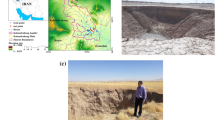Abstract
Karst rocky desertification in karst areas of Southwest China is an obstacle for the sustainable development of the locality. While many researchers have studied this issue, this study quantified the various indicators affecting desertification, using GIS technology to extract spatial data and to construct a RBFN (radial basis function network) model for Guizhou province. By calibrating sample data of the different levels of karst rocky desertification, the model parameters were established, and then the assessment of karst rocky desertification. Results show that in counties of Southwestern Guizhou Province karst rocky desertification is severe, counties in northern Guizhou have moderate desertification, and southeastern counties are affected lightly. Comparison of the results with other research shows conformity with actual conditions, proving the reasonability and applicability of the RBFN model.





Similar content being viewed by others
References
Cai Y (1990) The territorial structure and resources development in Guizhou province. Ocean Press, Beijing
Cai Y (1994) The study of alleviating poor and sustainable development in southwest karst areas. Peking University Press, Beijing
Cai Y, Meng J (1999) Ecological reconstruction of degraded land: a social approach.Sci Geogr Sin 19:198–203
Chen SS, Billings A, Grant PM (1990) Recursive hybrid algorithm for non-linear system identification using radial basis function networks.Int J Control 55:1051–1070
Chen SC, Cowan FN, Grant PM (1991) Orthogonal least squares learning algorithm for radial basis function networks IEEE Trans Neural Netw 2(2):302–309
Guizhou Bureau of Statistics (2000) Guizhou statistical yearbook. China Statistical Press, Beijing
Haykin S, (1991) Neural networks: a comprehensive foundation Prentice Hall, Englewood Cliffs, pp 213–214
Huang B (2000) Advance of the karst ecological test in laibing country. Carslogica Sin 19: 314
Li R, Wang S, Zhou D (2003) The correlation between rock desertification and lithology in karst area of Guizhou. Acta Geogr Sin 58:314–320
Li R, Wang S (2004) A study on rocky desertification evaluation index system.Trop Geogr 24:145–149
Moody J, Darken C (1989) Fast learning in networks of locally tuned processing units.Neural Comput 4:740–747
Musavi MT, Ahmed W, Chan KH, Faris KB, Hummels DM (1992) On the training of radial basis function classifiers.Neural Netw 5:595–603
Park J, Sandberg IW (1991) Universal approximation using radial basis function network.Neural Comput 3:246–257
Su W (2002) Controlling model for rocky desertification of karst mountainous region and its preventing strategy in southwest, China.J Soil Water Conserv 16:29–32
Tor B (1999) Geographic information systems: an introduction Wiley, New York, pp 124–125
Wang S (2003) The most serious eco-geologically environmental problem in southwestern China-karst rocky desertification. Bull Mineral Petrol Geochem 22:120–126
Wang S, Li Y (2003) Karst rocky desertification: formation background, evolution and comprehensive taming.Quaternary Sci 2:657–666
Xiong K (2002) The study of karst rocky desertification using the GIS & RS tech, a case study of Guizhou province. Geology Press, Beijing, pp 123–128
Yuan D, (1993) The karst study of China. Geology Press. Beijing
Yang H, (1995) Karst desertification and assessment of its disasters.Mar Geol Quaternary Geol 15:137–147
Zhang D, Wang S, Zhou D (2001) Intrinsic driving mechanism of land rocky desertification in karst regions of Guizhou province Bull Soil Water Conserv 21:1–5
Zhang H, Zhao X, Cai Y (1999) The driving mechanism of human forces to the land-use change in the karst mountain area Geogr Res 18:136–142
Acknowledgements
The research was supported by the Key Project of National Natural Science Foundation of China (40335046). The authors are grateful to Dr. Li Shuncheng and the anonymous reviewer for their comments and suggestions. However, any errors or shortcomings in the paper are our responsibility.
Author information
Authors and Affiliations
Corresponding author
Rights and permissions
About this article
Cite this article
Qiu-hao, H., Yun-long, C. Assessment of karst rocky desertification using the radial basis function network model and GIS technique: a case study of Guizhou Province, China. Environ Geol 49, 1173–1179 (2006). https://doi.org/10.1007/s00254-005-0162-4
Received:
Accepted:
Published:
Issue Date:
DOI: https://doi.org/10.1007/s00254-005-0162-4




